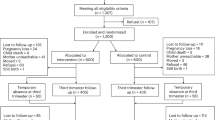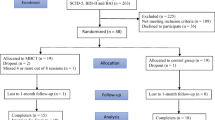Abstract
Along with physical and biological changes, a tremendous amount of upheaval and adjustment accompany the pregnancy and postpartum period of a woman’s life that together can often result in what is commonly known as postpartum depression. However, anxiety disorders have been found to be more frequent than depression during pregnancy and at least as common, if not more so, during the postpartum period, e.g., Brockington et al., (Archieves Women’s Ment Health 9:253–263, 2006; Wenzel et al. (J Anxiety Disord, 19:295–311, 2005). Cognitive-behavioral therapy (CBT) is a well-established psychological treatment of choice for anxiety; however, few studies have specifically examined a cognitive-behavioral intervention targeting perinatal anxiety. This pilot study examined the effectiveness of a cognitive-behavioral group treatment (CBGT) program specifically tailored to address perinatal anxiety in 10 women who were either pregnant or within 12 months postpartum. Participants were recruited from a women’s clinic at an academic hospital setting, with anxiety identified as their principal focus of distress. Following a diagnostic interview confirming a primary anxiety disorder and completion of assessment measures, participants completed a 6-week CBGT program. There was a statistically significant reduction in anxiety and depressive symptoms following the CBGT program (all p < 0.05). Participants also reported high acceptability and satisfaction with this treatment for addressing their perinatal anxiety. These findings suggest that CBGT for perinatal anxiety is a promising treatment for both anxiety and depressive symptoms experienced during the perinatal period. Further studies are needed to evaluate the treatment efficacy through larger controlled trials.
Similar content being viewed by others
References
Adewuya AO, Ola BA, Aloba OO, Mapayi BM (2006) Anxiety disorders among Nigerian women in late pregnancy: a controlled study. Archives Women’s Ment Health 9:325–328
Antony MM, Orsillo SM, Roemer L (eds) (2001) Practitioner’s guide to empirically based measures of anxiety. Kluwer Academic/Plenum, New York
Austin M-P, Hadzi-Pavlovic D, Leader L, Saint K, Parker G (2005) Maternal trait anxiety, depression and life event stress in pregnancy: relationships with infant temperament. Early Hum Dev 81:183–190
Austin MP, Frilingos M, Lumley J, Hadzi-Pavlovic D, Roncolato W, Acland S et al (2008) Brief antenatal cognitive behavior therapy group intervention for the prevention of postnatal depression and anxiety: a randomised controlled trial. J Affect Disord 105:35–44
Bandelow B, Sojka F, Broocks A, Hajak G, Bleich S, Ruther E (2006) Panic disorder during pregnancy and the postpartum period. Eur Psychiatr 21:495–500
Barnett B, Schaafsma M, Guzman A, Parker G (1991) Maternal anxiety: a 5-year review of an intervention study. J Child Psychol Psychiatry 32:423–438
Beck CT, Driscoll JW (2006) Postpartum mood and anxiety disorders: a clinician’s guide. Jones and Bartlett, Boston
Beeghly M, Weinberg MK, Olson KL (2002) Stability and change in level of maternal depressive symptomatology during the first postpartum year. J Affect Disord 71:169–180
Bennett HA, Einarson A, Taddio A, Koren G, Einarson TR (2004) Prevalence of depression during pregnancy: systematic review. Obstet Gynecol 103:698–709
Bieling PJ, McCabe RE, Antony MM (2006) Cognitive behavioral therapy in groups. Guilford Publications, New York
Borkovec TD, Costello E (1993) Efficacy of applied relaxation and cognitive behavioral therapy in the treatment of generalized anxiety disorder. J Consult Clin Psychol 61:611–619
Brockington IF, Macdonald E, Wainscott G (2006) Anxiety, obsessions, and morbid preoccupations in pregnancy and the puerperium. Archieves Women’s Ment Health 9:253–263
Brown TA, Antony MM, Barlow DH (1992) Psychometric properties of the Penn State Worry Questionnaire in a clinical anxiety disorders sample. Behav Res Ther 30:33–37
Cox JL, Holden JM, Sagovsky R (1987) Detection of postnatal depression: development of the 10-item Edinburgh postnatal depression scale. Br J Psychiatry 140:111–117
First MB, Spitzer RL, Gibbon M, Williams JBW (1995) Structured clinical interview for DSM-IV axis I disorders. Biometrics Research Department, New York
Gaynes, B., N., Gavin, N., Meltzer-Brody, S., Lohr, K. N., Swinson, T., Gartlehner, G., et al. (2005). Perinatal depression: prevalence, screening accuracy, and screening outcomes. Evid Rep Technol Assess (Summ).119, 1–8.
Gondoli DM, Silverberg SB (1997) Maternal emotional distress and diminished responsiveness: the mediation of parenting efficacy and parental perspective taking. Dev Psycholology 33:861–868
Green, S., Goldfinger, C., Rowa, K., Chudzik, S., McCabe, R. (2014). Examining worry content in a perinatal population with GAD. Canadian Psychological Association (Vancouver, BC), 55:2a.
Griffiths P, Barker-Collo S (2008) Study of a group treatment program for postnatal adjustment difficulties. Archieves Women’s Ment Health 11:33–41
Larsen DL, Attkisson CC, Hargreaves WA, Nguyen TD (1979) Assessment of client/patient satisfaction: development of a general scale. Eval Program Plan 2:197–207
Levois M, Nguyen TD, Attkisson CC (1981) Artifact in client satisfaction assessment: experience in community mental health settings. EvalProgram Plan 4:139–150
Maina G, Alber U, Bogetto F, Vaschetto A, Ravizza L (1999) Recent life events and obsessive-compulsive disorder (OCD): the role of pregnancy delivery. Psychiatry Res 89:49–58
Matthey S, Barnett B, Howie P, Kavanagh DJ (2003) Diagnosing postpartum depression in mothers and fathers: whatever happened to anxiety? J Affect Disord 74:139–147
Metesacker B, Bade U, Haverkock A, Pauli-Pott U (2004) Predicting maternal reactivity/sensitivity: the role of infant emotionality, maternal depressiveness/anxiety, and social support. J Infant Ment Health 25:47–61
Meyer TJ, Miller MJ, Metzger RL, Borkovec TD (1990) Development and validation of the Penn State Worry Questionnaire. Behav Res Ther 28:487–495
Milgrom J, Negri LM, Gemmill AW, McNeil M, Martin PR (2005) A randomized controlled trial of psychological interventions for postnatal depression. Br J Clin Psychol 44:529–542
Misri S, Reebye P, Corral M, Mills L (2004) The use of paroxetine and cognitive behavioral therapy in postpartum depression and anxiety: a randomised controlled trial. J Clin Psychiatry 65:1236–1241
Molina S, Borkovec TD (1994) The Penn State Worry Questionnaire: psychometric properties and associated characteristics. In: Davey GCL, Tallis F (eds) Worrying: perspectives on theory, assessment, and treatment. Wiley, New York, pp 265–283
Moses-Kolko EL, Bogen D, Perel J, Bregar A, Uhl K, Levin B, Wisner KL (2005) Neonatal signs, after late in utero exposure to serotonin reuptake inhibitors: literature review and implications for clinical applications. J Am Med Assoc 293:2372–2383
O’Connor TG, Heron J, Golding J, Glover V, the ALSPAC Study Team (2003) Maternal antenatal anxiety and behavioral emotional problems in children: a test of a programming hypothesis. J Child Psychol Psychiatry, Allied Discipl 44:1025–1036
O-Hara MW, Swain AM (1996) Rates and risk of postpartum depression: a meta-analysis. Int Rev Psychiatry 8:37–54
Orr ST, Reiter JP, Blazer DG, James SA (2007) Maternal prenatal pregnancy-related anxiety and spontaneous preterm birth in Baltimore, Maryland. Psychosom Med 69:566–570
Otto MW, Smits JA, Reese HE (2004) Cognitive-behavioral therapy for the treatment of anxiety disorders. J Clin Psychiatry 65:34–41
Ross LE, McLean LM (2006) Anxiety disorders during pregnancy and the postpartum period: a systematic review. J Clin Psychiatry 67:1285–1298
Sholomskas DE, Wickamaratne PJ, Dogolo L, O’Brian DW, Leaf PJ, Woods SW (1993) Postpartum onset of panic disorder: a coincidental event. J Clin Psychiatry 54:476–480
Soet JE, Brack GA, Dilorio C (2003) Prevalence and predictors of women’s experience of psychological trauma during childbirth. Birth 30:36–46
Sturmey P (2009) Behavioral activation is an evidence-based treatment for depression. Behav Modif 33:818–829
Sutter-Dallay AL, Giaconne-Marcesche V, Glatigny-Dallay E, Verdoux H (2004) Women with anxiety disorders during pregnancy are at increased risk of intense postnatal depressive symptoms: a prospective survey fo the MATQUID cohort. Eur Psychiatry 19:459–463
Vesga-Lopez O, Schneier FR, Wang S, Heimberg RG, Liu SM, Hasin DS, Blanco C (2008) Gender differences in generalized anxiety disorder: results from the National Epidemiological Survey on Alcohol and Related Conditions. J Clin Psychiatry 69:1606–1616
Wenzel A (2011) Anxiety in childbearing women: diagnosis and treatment. American Psychological Association, Washington, DC
Wenzel A, Haugen E, Jackson L, Brendle J (2005) Anxiety symptoms and disorders at 8 weeks postpartum. J Anxiety Disord 19:295–311
Wittchen HU, Carter RM, Pfister H, Montgomery SA, Kessler RC (2000) Disabilities and quality of life in pure and comorbid generalized anxiety disorder and major depression in a national survey. Int Clin Psycholopharmacology 15:319–328
Zeanah CH, Borris N, Scheeringa M (1997) Psychopathology in infancy. J Child Psychol Psychiatr Allied Discip 38:81–99
Author information
Authors and Affiliations
Corresponding author
Rights and permissions
About this article
Cite this article
Green, S.M., Haber, E., Frey, B.N. et al. Cognitive-behavioral group treatment for perinatal anxiety: a pilot study. Arch Womens Ment Health 18, 631–638 (2015). https://doi.org/10.1007/s00737-015-0498-z
Received:
Accepted:
Published:
Issue Date:
DOI: https://doi.org/10.1007/s00737-015-0498-z




